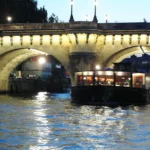Wandering through Amsterdam’s graceful canals and narrow gabled houses, the Anne Frank House stands as a poignant reminder of hope, courage, and history. This iconic museum, nestled along the Prinsengracht canal, invites visitors to step softly into the hidden world of Anne Frank, a young girl whose diary touched millions. Whether you arrive from the bustling city center, Amsterdam Airport Schiphol, or Central Station, this historic site integrates easily into any exploration of Dutch culture, heritage, and memory.
Table of Contents
Locating the Anne Frank House in Amsterdam
In the heart of Amsterdam’s 17th-century canal ring, the Anne Frank House lies on Prinsengracht 263-267. From Central Station, a gentle 20-minute walk along the scenic canals leads you directly to its doorstep. Alternatively, tram lines 13 and 17 stop nearby at Westermarkt, just minutes from the entrance.
Visitors coming from Schiphol Airport can take the train to Central Station, or if you prefer a scenic approach, consider the airport bus to Leidseplein and then walk or catch a tram to the museum area. Surrounding streets offer plenty of local cafés and cozy eateries, a perfect pause to taste traditional Dutch delights like stroopwafels or fresh herring.
Echoes of the Past: The Anne Frank House’s Importance
The Anne Frank House preserves the secret annex where Anne Frank and her family hid during World War II, from 1942 to 1944. Anne’s diary, written in the very rooms behind these walls, reveals a tender and insightful glimpse into a childhood interrupted by war. The museum is not merely a memorial but a beacon of tolerance, human rights, and the resilience of the human spirit.
Walking through the dimly lit rooms, one senses an almost sacred quietude, punctuated by Anne’s hopeful words and the stark realities of hiding and survival. The building itself is a testament to Amsterdam’s layered history-medieval foundations beneath 20th-century woodwork-mirroring the complexity of memory and identity.
Planning Your Visit: Tickets and Tours
To respect the solemnity and popularity of this historic landmark, advanced ticket reservation is essential. Tickets are released two months before the intended visit date and often sell out quickly, especially in peak seasons.
- Online booking is strongly recommended to avoid long queues.
- Guided tours, including audio guides in multiple languages, enrich understanding and provide nuanced historical context.
- The museum limits daily visitors to preserve the atmosphere and the artifact integrity.
The official museum website offers a seamless booking experience for ticket purchases, visitor information, and updates on exhibitions.
Best Moments to Visit: Smart Timing Tips
Timing your visit can enhance the experience profoundly. Weekdays, especially Tuesdays and Wednesdays, generally see fewer visitors than weekends. Early morning entries right after opening provide a more intimate atmosphere, allowing space to absorb the exhibits without rush.
Off-peak months from November to February typically have lower crowds and a reflective chill in the air, matching the introspective mood of the museum. However, be prepared for shorter daylight hours and colder weather during these months.
Nearby Comforts: Where to Stay and Eat
Close to the Anne Frank House, Amsterdam offers a charming tapestry of accommodations, ranging from boutique guesthouses nestled in canal houses to modern apartments with views over tranquil waterways. Staying near the Jordaan neighborhood will immerse you in one of Amsterdam’s most treasured areas-home to art galleries, artisanal shops, and leafy courtyards.
For local flavors, cafés lining the canals invite you to pause with a warm cup of coffee or enjoy Dutch cheeses and fresh-baked breads. Do not miss sampling poffertjes, small fluffy pancakes dusted with powdered sugar, available in market squares or dedicated stalls. Taste the city not just through sights but through these authentic culinary moments.
Beyond the Museum: Capturing Amsterdam’s Spirit
After visiting the Anne Frank House, extend your exploration to the nearby Westerkerk tower, which Anne Frank admired from her annex window, and the lively neighborhood markets where locals gather. This area is rich with stories written in cobblestones, from resistance movements during the war to contemporary creative expressions in murals and craft shops.
Photography enthusiasts will appreciate the interplay of light reflecting off canal waters and brick facades, especially during the golden hours of dawn or dusk. The area’s historic streets offer compelling architectural textures-from Renaissance facades to art nouveau details-worthy of patient study and photographic documentation.
Final Thoughts: A Visit with Resonance
Visiting the Anne Frank House is not just a walk into history; it is an encounter with human resilience and a stirring call to empathy and understanding. The museum’s quiet corners and poignant exhibits invite reflection long after you exit back into Amsterdam’s buzzing streets. Booking ahead, choosing the right time, and immersing yourself in the local environment enrich this deeply moving experience, anchoring memories that travel with you beyond your stay.
To complement your visit to the Anne Frank House, explore the must-see landmarks and culture spots of Amsterdam to embrace the city’s full charm beyond the museum.

Lover of cities, local cafés, and historic streets, exploring urban life with attention to architecture and culinary delights.
- Anne Frank House (Museum), Amsterdam 03 by Ank Kumar on Wikimedia Commons – cc by-sa 4.0
